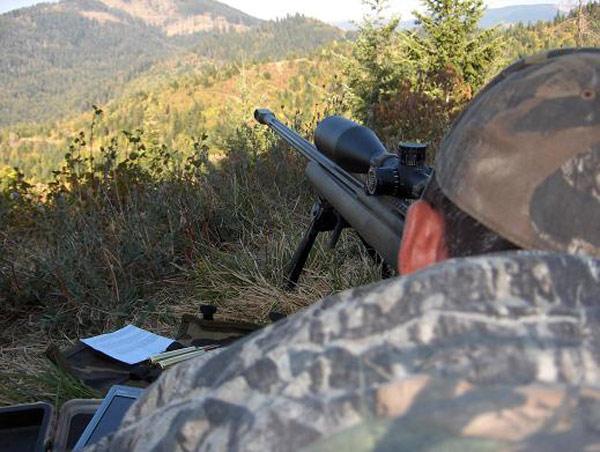Long Range Hunting Ambush

Now that we have setup with a minimal amount of noise we are ready to get started. I first start by a quick scan with the naked eye for movement or colors that don't fit. Next I break out the binoculars and will spend the vast majority of my time behind these. I start on the travel routes first trails, saddles, and ridge tops I can see. Next I move to a section on my range card and grid search it. If I locate any odd shape or detect an animal I switch to the spotting scope for confirmation. If my search has not turned up anything at this point I will get behind the spotting scope and start to work over areas for bedded animals. I am looking for a small part of the animal at this point. The beauty of locating one on the ground is you have all day to setup for your shot and then wait for a good target presentation.
When I have located a target I first get behind the rifle. Next determine the range from my range card and laser it again if I have time. I consider up/down angles and dial in my elevation adjustment. Next I make a determination of the wind speed and direction and pick a hold off point for this. I prefer not to dial in for wind, if I feel like that the wind is strong enough that I should dial it in instead of hold off I would pass on the shot. Much like wind I hold the same criteria for moving game. I prefer to get the animal to stop, but if I choose to take a moving shot I will only take it at the distance where a small hold off works. Remember that a flat fast shooting rifle will take .4 of a second to travel 400 yards. During .4 seconds at 400 yards an animal walking 3 mph will need around 22" of lead. That means that the animal will move 22" after you pull the trigger. In steep country one step after the firing pin drops could also mean a 22" drop down in the animal's position resulting in a miss or even worse a wounded animal. I just don't take long range moving big game shots.
Now that I have corrected for elevation and windage I take the shot. Now is where it pays to have a hunting partner. If you have a spotter he can call your hit and direct an additional shot if needed. If you don't have a spotter you are pretty much obligated to hike over to the shot location to assess the possible hit. A hunting partner and a pair of hand held radios make this task much easier. Also be smart about your shot, if an animal is feeding along a hillside or moving down a trail, take you shot in a spot that is easier to spot your hit and track from. Remember the long range ambush is used to give the hunter, the ability to pick the shot, the presentation, and use his ballistic advantage.
Proper setup and execution of the long range ambush will allow you to areas that were not huntable from within and allow you a whole new way to look at your hunting areas.
Join the discussion of this article with the author HERE at the Article Discussion Forum.
Shawn Carlock is a veteran law enforcement sniper and the current USPSA national precision rifle champion. He runs his business building custom rifles and conducting precision rifle training for civilian and law enforcement interests.
Defensive Edge - Long Range Hunting Videos
